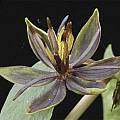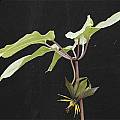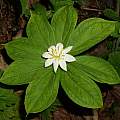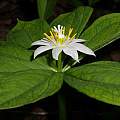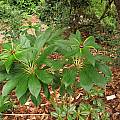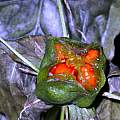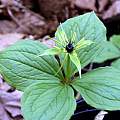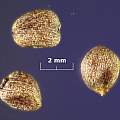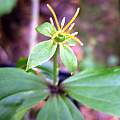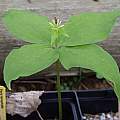Paris L. is a genus of perennial herbs arising from rhizomes that may be thin or tuberous. Atop a simple stem sits a solitary whorl of from 4 to 22+ leaves. Solitary, bisexual flowers sit atop a simple flower stalk. The green or red ovary may have one chamber or 4+. One chambered plants are called Daiswa. The style base may be purplish, red, white or yellow. Seeds may or may not have an aril and can be red, white or brown. Tepals are arranged in 2 whorls of 3-8: outer ones are green, rarely white; inner ones may be absent and can be green, purplish or yellow-green. Stamens are arranged in 2-3 whorls, filaments are flat and narrow, free portion of the connective may be relatively long, short, or globose.
Recent publications have split Paris into Paris, Daiswa and Kinugasa. For simplicity we will refer to all of the non-trillium Trilliaceae, (considered belonging to Melanthiaceae) by some as Paris.
Species are native to Eurasian temperate, deciduous woodlands. They prefer mildly acid to acidic, moisture retentive, rich, light, well drained woodsy soils with deciduous leaf mulch in the fall. They may go dormant in the late summer and resent transplanting. Best in USDA zones 5-8, impossible in tropical Florida, very difficult in Southern California or the desert Southwest. Plants may take from 4-7 years to flower from seed.
In the online Flora of China is a key to the 20+ Chinese species and there may be further information in the Trillium discussion list.
Information above furnished by Mark Mazer as part of the pbs list May 2004 topic of the week. Introduction
Paris delavayi Franch., syn. Daiswa delavayi (Franch.) Takht., is from Northwest China and Vietnam. Height range: 6-20 ft. Photos from Mark Mazer.
Paris japonica (Franch. & Sav.) Franch., syn. Kinugasa japonica (Franch. & Sav.) Tatew. & Sutô, is native to open woods in the mountains of northern Japan. A large, showy white flower blooms in May-August on a pedicel rising from a whorl of broad, pointed leaves. A purple berry follows. Mature plants can be almost 100 cm (40") tall. This species needs dappled shade and deep, slightly acid, organic soil that is constantly moist yet well aerated and free-draining. In the wild, large populations are found on slopes. Like some of its Trillium cousins, it may not bloom for a year or two after the shock of being transplanted. Photos and text from Paige Woodward.
Paris polyphylla Sm., syn. Daiswa polyphylla (Sm.) Raf., is a species distributed from the Himalaya to China. The first two photos below were taken by Nhu Nguyen of a specimen collected in Sichuan Province, China. It grows to about a meter tall in a shady spot at the UC Botanical Garden. The last photo was taken by Paige Woodward.
Paris quadrifolia L. is native to much of Europe and Asia, including Russia (Siberia), Mongolia and the Chinese provinces of Heilonjiang and Xinjiang. According to Paige Woodward who supplied photo 1, this species grows to 15-25 cm (6-10") and is hardy to at least Zone 6. It has four leaves in two opposite pairs, whorled flowers with four yellow-green outer tepals and four threadlike inner ones followed by a dark blue berry. Photo 2 of seed by David Pilling, photo 3 by Martin Bohnet shows ripe berries in August on plants in habitat on the Swabian Jura.
Paris tetraphylla A.Gray is a woodlander native to Sakhalin Island and Japan growing to 40 cm (16 in) and hardy to Zone 6. It has four green leaves in opposite pairs topped by a whorled flower made of green outer tepals and slender, "feathery" inner tepals that match the yellow stamens in color. Information and photos supplied by Paige Woodward.
